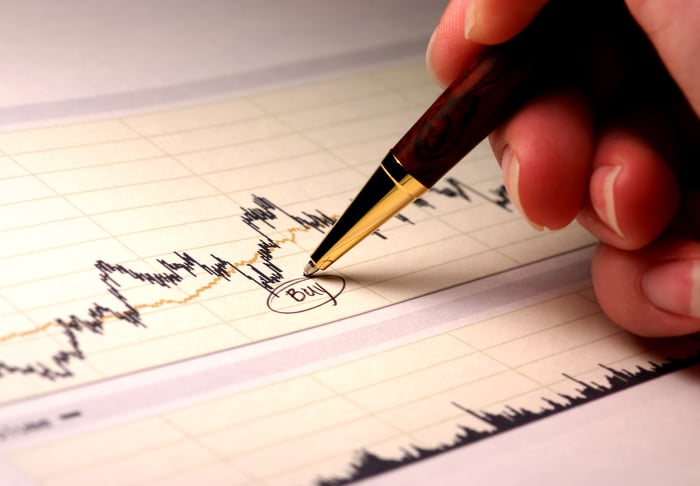For the past 19 months, Wall Street and investors have sat back and enjoyed the strongest bounce from a bear-market bottom in history. Since the broad-based S&P 500 (^GSPC -0.21%) bottomed on March 23, 2020, the index has more than doubled in value. For context, the S&P 500 has averaged a total return, including dividends, of just north of 11% since the beginning of 1980.
But at the same time, there's also no denying that the catalysts for a stock market crash or correction are building.

Image source: Getty Images.
Crashes and corrections are an inevitable part of the investing process
To be clear, we're never going to know ahead of time when a crash or correction will begin, how long it'll last, or how steep the decline will be. In many instances, we're also unclear on what'll cause the market to dive until after the fact. However, there are clues to suggest this historic rally in equities could soon cool off.
For example, the frequency of double-digit declines provides a warning. Over the past 71 years, the S&P 500 has dropped by at least 10% on 38 separate occasions. Averaged out, we're talking about a double-digit decline every 1.87 years. Even though Wall Street doesn't adhere to averages, it's worth pointing out that we're now more than 1.5 years removed from the last double-digit drop.
History is also pretty clear that bouncing back from a bear market is a bumpy process. Following each of the previous bear-market bottoms, dating back to 1960, there were either one or two declines of at least 10% within 36 months. The current rally is now 19 months old, and we've yet to see a double-digit pullback.
Valuation provides a cautionary tale, too. The S&P 500's Shiller price-to-earnings (P/E) ratio, which examines inflation-adjusted earnings over the previous 10 years, stood at 38.5 at the close on Oct. 19. Aside from being more than double the 151-year average of 16.9, a sustained Shiller P/E above 30 has previously spelled trouble. The previous four times the Shiller P/E surpassed 30 led to a subsequent decline in the S&P 500 of at least 20%.

Image source: Getty Images.
These stocks are no-brainer buys if there's a market crash
Despite these concerns and the inevitability of crashes and corrections, every notable dip in the market has historically been a buying opportunity. As long as your investment time frame is measured in years and not days or weeks, a stock market crash is nothing more than a clearance sale for high-quality companies.
If a crash or correction does occur in the near future, the following three stocks would make for no-brainer buys.
First up is social media giant Facebook (META -0.09%), whose growth has been relatively unfazed for well over a decade.
When the curtain closed on the second quarter, Facebook had 2.9 billion monthly active users (MAUs) visiting its namesake site, along with 610 million unique MAUs visiting Instagram and/or WhatsApp, which it also owns. That's 3.51 billion MAUs, which equates to more than half the world's adult population. Advertisers are well aware that there's no platform on the planet where they can reach a broader audience, and they'll, therefore, spend big bucks to get their message in front of these users.
Aside from having exceptional ad pricing power, Facebook hasn't even fully depressed the gas pedal when it comes to its growth potential. It's on pace to generate more than $100 billion in ad revenue this year solely from its namesake site and Instagram. Once WhatsApp and Facebook Messenger are meaningfully monetized, its growth potential can kick into another gear.
With aspirations of becoming a leader in virtual reality, as well, Facebook offers the perfect blend of sustainable double-digit growth and value that investors looking for great deals during a crash will appreciate.

Image source: U.S. Bank.
U.S. Bancorp
Another no-brainer stock to buy if market volatility picks up is regional bank U.S. Bancorp (USB -1.06%). This is the parent company of the more familiar U.S. Bank.
On one hand, bank stocks are highly cyclical and therefore at risk of seeing their operating performance adversely affected by recessions or periods of heightened volatility. On the other hand, crashes, corrections, and recessions are all relatively short-lived events.
The average double-digit decline in the S&P 500 since 1950 has only lasted about six months. Meanwhile, periods of economic expansion and bull markets often last for years. Bank stocks like U.S. Bancorp are able to take advantage of these disproportionately long periods of expansion to expand their loan portfolios and generate more net interest income.
More specific to U.S. Bancorp, it's avoided the riskier derivative investments that sacked larger money-center banks during the Great Recession and focused its efforts on going digital. In the September-ended quarter, the company notes 80% of total transactions were completed digitally (online or via mobile), compared to 67% in the comparable quarter in 2019. Digital transactions are considerably cheaper than in-person and phone-based interaction, which is allowing the company to consolidate its branches, lower its expenses, and become more efficient.

Image source: Getty Images.
Mastercard
Among financial stocks, payment facilitator Mastercard (MA 0.01%) is another no-brainer buy if there's a stock market crash.
Like U.S. Bancorp, Mastercard benefits from disproportionately long periods of economic expansion. Even though recessions are inevitable, and consumers will holster their disposable income during periods of uncertainty, periods of expansion last far longer. Thus, Mastercard is playing a numbers game that strongly favors the patient.
Mastercard finds itself as the No. 2 in credit card network purchase volume in the U.S., which is the largest market for consumption in the world. It's also set up nicely to expand its infrastructure to underbanked regions, including Southeastern Asia, the Middle East, and Africa. With most global transactions still being conducted in cash, Mastercard's opportunity for sustained double-digit growth is promising.
What's more, Mastercard strictly sticks to payment processing and doesn't lend money. While some would argue it's giving up the opportunity to collect interest income and fees during long periods of economic expansion, this avoidance of lending also ensures that it isn't directly exposed to rising credit delinquencies during economic contractions. Not having to set aside capital for potential credit loan losses is precisely why Mastercard bounces back from downturns faster than most financial stocks.





